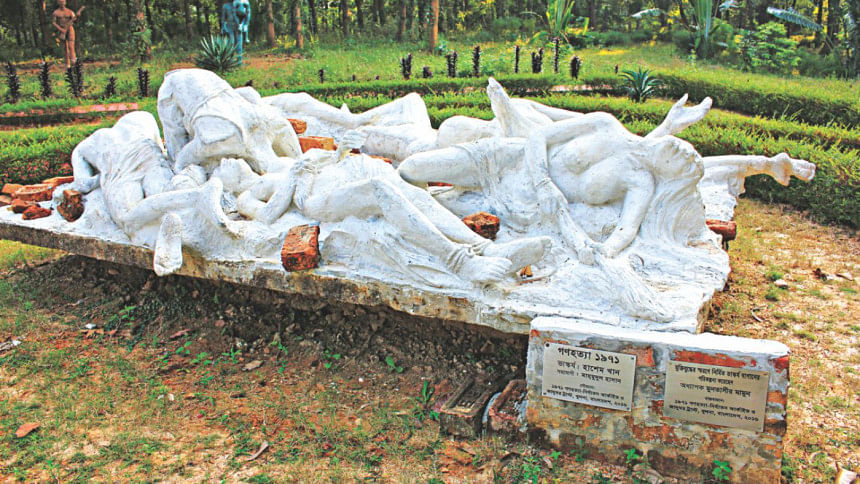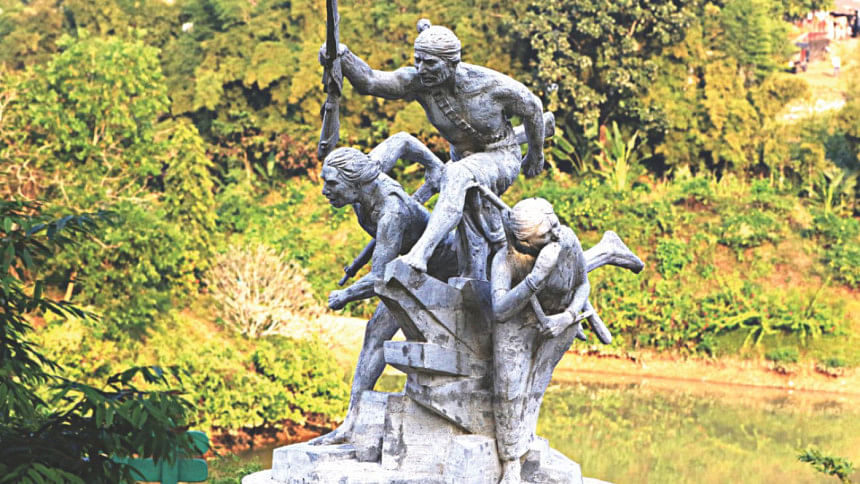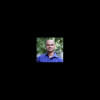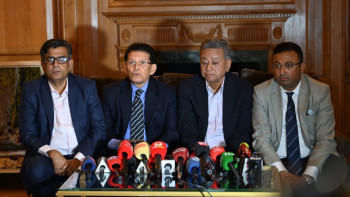Serenading the sublime souls of the nations

The people of India extended their all-out support to the Liberation War of Bangladesh. Freedom fighters of our country and Indian soldiers fought together to free the country from Pakistani occupational forces. The neighbouring Indian states of West Bengal, Tripura, Assam and Meghalaya were the greatest support providers as they bore the burden of ten million refugees pouring across their borders.
While Kolkata served as the political heart of our liberation struggle, Agartala and several other locations in Tripura alongside the international border served as the military hubs of our war endeavours in 1971. Most of the operations carried out in Dhaka city emanated from Tripura. More importantly, the Agartala Case instituted against Bangabandhu Sheikh Mujibur Rahman had created a very special linkage between Bangladesh and Tripura.
The memorial park was a long cherished demand of Tripura people as they were actively involved in the Liberation War. They provided all-out support to Freedom Fighters and sheltered around 1.6 million people, a number exceeding the then population of the state.

Bharat-Bangladesh Maitree Udyan (India-Bangladesh Friendship Park) in Chottakhola was one of the base camps of Bangladeshi Freedom Fighters from where they launched guerrilla warfare against the Pakistani army in Chittagong, Comilla and greater Noakhali.
Located near the international border, the Maitree Udyan is a park built at Chottakhola as a tribute to Indian soldiers and Bangladeshi Freedom Fighters who sacrificed their lives during the Liberation War. A war museum, hillocks, verdant valleys, lakes, plants, sculptures, graveyards of Bangladeshi Freedom Fighters with various other elements, this is not just a park but much more than that.
Chottakhola, 130 kilometres from Tripura's capital Agartala, had functioned as one of the 11 warfront-camps in Tripura in 1971. The then Bangladesh Foreign Minister Dipu Moni laid the foundation stone of the park on 11 November 2010.
The beautiful location comprises of seven hillocks partly separated by a natural lake over 20 hectares of land. It saw intense activities during the Liberation War and still bears its memorabilia in the form of remnants of a number of bunkers and trenches built on it in 1971.
A training camp of the Freedom Fighters was located on the site and people around say that two Freedom Fighters were laid to eternal rest here, though the exact locations of their graves are yet to be traced. Parts of the hillocks were also used as a refugee camp. Awami League leader and a member of the then Provincial Assembly (MPA) from Noakhali, Khaja Ahmed, founded the training camp at Chottakhola in 1971. People of the locality remember him fondly. They also remember student leader of the time, A. S. M. Abdur Rob, and noted Left leader Rashed Khan Menon, who had been to that site during the Liberation War.
The park includes an elaborate garden, museum, children's park and helipad, and is connected to the neighbouring handicraft producing village with another wooden bridge. Accommodations with modern facilities, with village-home decoration, have been situated across the road running by the side of the site. A chestnut garden flanks the other side of the park.
With Chottakhola being a part of the reserve forest area, the Ministry of Forest in Tripura has implemented the project as an eco-park. It is situated within the Trishna Wild Animal Sanctuary and is well-known for the bison that it shelters. The ministry developed a 3 kilometre trail, starting from the memorial park, going through the forests -- with camping arrangements in between -- and ending in a recently excavated mosque from Mughul times situated on top of another hill.
The government of Tripura organises a solidarity fair and festival on the site every year -- beginning on November 6, the date of Babri Mosque demolition -- to express solidarity with religious minorities of the country and highlight secularism as a cardinal state policy. The Tripura government has planned to develop the area so that visitors can spend a day or two in the area and get a glimpse of the historical ties and friendship between two neighbouring countries as well as the natural beauty.
A museum exhibiting arms and ammunition, war materials, rare photographs, newspapers and war-time literature would also be set up in the area, which has already turned into a memorial and ecological conservation zone.
Tripura Chief Minister Manik Sarkar inaugurated the memorial and park in the presence of Indian and Bangladeshi artists, intellectuals and freedom fighters on December 16, the Victory Day of Bangladesh.
Statues of the then Prime Minister Indira Gandhi and the founder of Bangladesh, Bangabandhu Sheikh Mujibur Rahman, have also been erected in the park.
Renowned artists from Tripura and Bangladesh are part of the project with their creations -- from statues to paintings -- that added to the memorial's attraction.
Political analyst and writer Gautam Das, a close observer of the Liberation War, told The Daily Star: “Over 160,000 displaced people from the then East Pakistan had taken shelter in Tripura during the War of Liberation. Our state had many camps in four sectors from where the Freedom Fighters fought the Pakistani forces in the nine-month-long war. Even after 46 years, the people of Tripura understand the need to celebrate the indomitable spirit of the Freedom Fighters and Indian soldiers who fought shoulder to shoulder to liberate an oppressed land. The memorial and the park will certainly ensure that the nine-month-long bloody war is never forgotten.”
The Department of Forest is building the park in memory of those sacrificed their lives to liberate Bangladesh. The lush green park is spread in 20 hectares of land with seven hillocks and a serpentine lake is being dug up on their feet. A 52-feet high tower was also built in the park from where parts of Noakhali and Feni districts of Bangladesh are seen.
The government of Tripura sought collaboration from Bangladesh in designing the park and invited eminent artist Hashem Khan, architect Mobassir Hossain, historian Professor Muntasir Mamun and historian Professor Mesbah Kamal to that end.
The memorial park would help successive generations of Bangladesh learn the history of their hard won independence and how the two friendly neighbours joined forces to bring about the country's liberation.

 For all latest news, follow The Daily Star's Google News channel.
For all latest news, follow The Daily Star's Google News channel. 



Comments